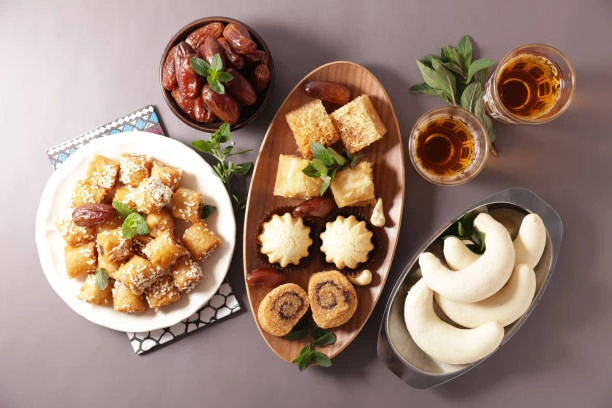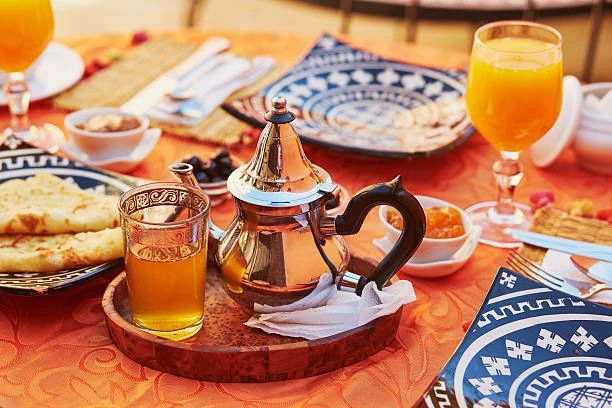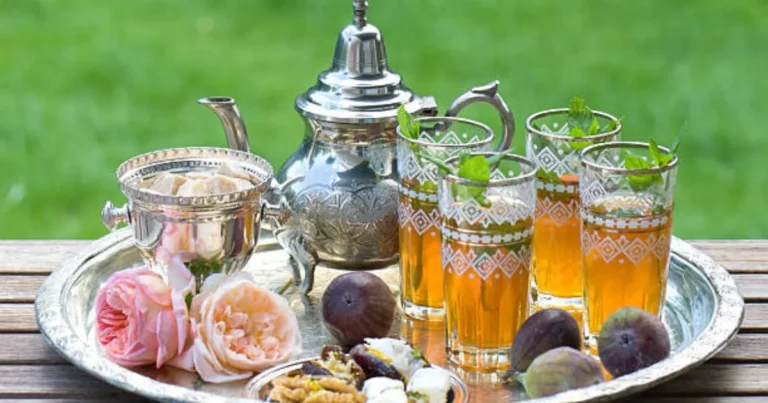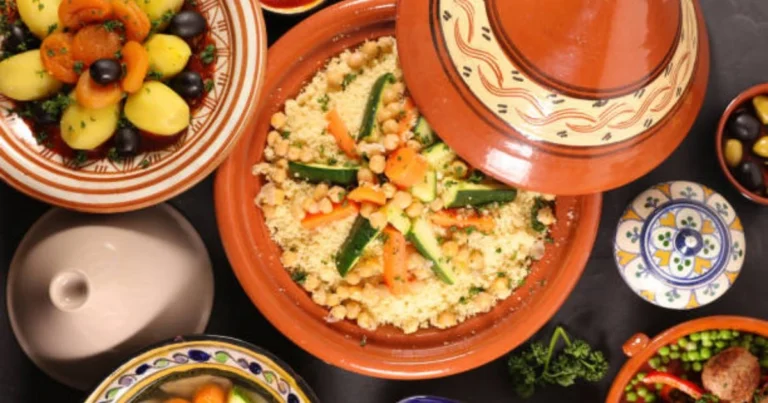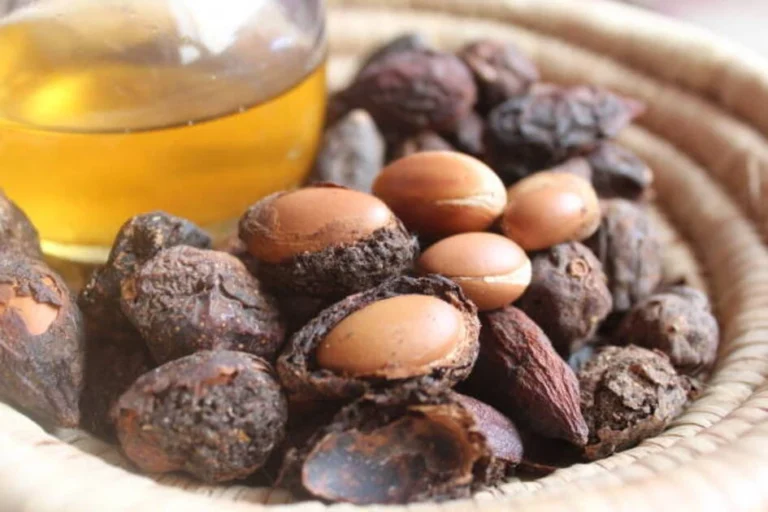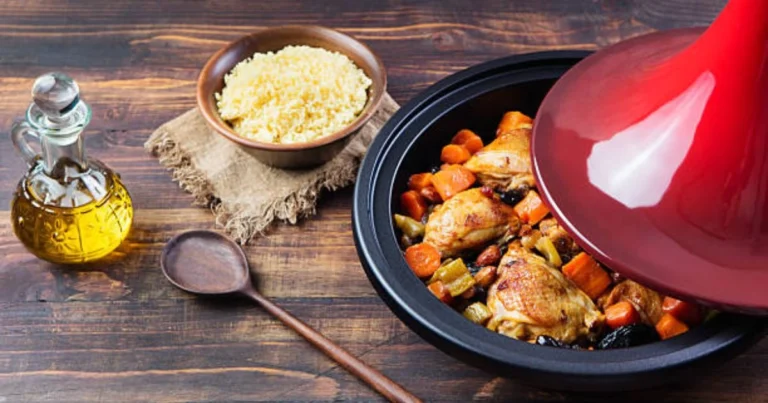Top Moroccan Desserts You Can’t Resist
You might be surprised to learn that traditional Moroccan sweets are not typically served after meals, but rather enjoyed during mid-afternoon tea time.
This unique cultural practice highlights the significance of these sweet treats in Moroccan culture. As you explore the world of Moroccan food desserts, you’ll discover a rich variety of flavors and textures that are sure to captivate your senses.
From sweet pastries to fragrant cakes, the diversity of these desserts is a testament to the country’s rich culinary heritage. Get ready to indulge in the delightful world of Moroccan sweets and experience the warmth of Moroccan hospitality.
Table of Contents
The Sweet World of Moroccan Cuisine
As you explore Moroccan cuisine, you’ll discover a treasure trove of sweet treats that are deeply rooted in the country’s rich cultural heritage. Moroccan desserts are not just a delight for the taste buds but also play a significant role in the country’s social and cultural fabric.
The Cultural Significance of Desserts in Morocco
In Morocco, desserts are an integral part of hospitality and are often served during special occasions and celebrations. The art of making these sweet treats is passed down through generations, with each family having their own secret recipes. You can experience the warmth of Moroccan hospitality by indulging in these delicious desserts, which are typically served with a cup of Moroccan mint tea, a staple in Moroccan culture.
The significance of desserts in Moroccan culture extends beyond just their taste; they are also a symbol of generosity and warmth. When you visit a Moroccan home, you’re likely to be offered a variety of sweet pastries and desserts as a sign of respect and welcome.
The Influence of Arab, Berber, and Mediterranean Traditions
Moroccan desserts are a perfect blend of Arab, Berber, and Mediterranean traditions. The use of ingredients like almonds, honey, and orange blossom water reflects the Arab influence, while the Berber traditions are evident in the use of local ingredients and simple preparation methods. The Mediterranean diet’s emphasis on nuts, fruits, and olive oil also plays a significant role in shaping Moroccan desserts.
You can taste the diversity of Moroccan cuisine in its desserts, which range from the intricate pastries filled with almond paste to the simple yet delicious dates stuffed with nuts. The blend of these traditions has resulted in a unique and flavorful dessert culture that is quintessentially Moroccan.
Essential Ingredients in Traditional Moroccan Desserts
Traditional Moroccan desserts are a symphony of flavors, with ingredients like honey and spices playing key roles. The rich culinary heritage of Morocco is reflected in the diverse ingredients used in its desserts.
The Role of Nuts and Dried Fruits
Nuts and dried fruits are staples in Moroccan desserts, providing texture and flavor. Almonds, walnuts, and pistachios are commonly used, often in conjunction with dried fruits like dates, apricots, and prunes. These ingredients are not only delicious but also nutritious, making Moroccan desserts a delightful treat.
Honey, Orange Blossom Water, and Rose Water
Honey, orange blossom water, and rose water are essential in giving Moroccan desserts their distinct aroma and taste. Honey is used as a sweetener, while orange blossom water and rose water add a fragrant and floral note to the sweets. These ingredients are often combined in various ways to create unique flavor profiles.
Spices That Define Moroccan Sweets
Spices play a crucial role in Moroccan desserts, with cinnamon, anise, and cardamom being particularly popular. These spices add warmth and depth to the sweets, making them even more appealing. The use of spices in Moroccan desserts reflects the country’s rich cultural and culinary traditions.
Most Popular Moroccan Desserts You Need to Try
Moroccan desserts are known for their unique flavors and ingredients, making them a must-try. Moroccan cuisine offers a diverse range of sweet treats that are deeply rooted in the country’s cultural and religious traditions. You can experience the rich flavors of Morocco by trying out some of its most popular desserts.
Chebakia: The Honey-Soaked Sesame Cookie
Chebakia is a traditional Moroccan dessert typically enjoyed during Ramadan. These delicious cookies are made with honey, sesame seeds, and flour, giving them a unique taste and texture. You can make Chebakia at home by frying dough shapes in oil and then soaking them in a honey syrup infused with sesame seeds and other spices.
Sellou: The Sacred Ramadan Treat
Sellou, also known as “Slilou,” is another significant dessert during Ramadan. It’s made with a mixture of flour, nuts (such as almonds), and spices like cinnamon and ginger, giving it a warm, aromatic flavor. You can prepare Sellou by roasting the ingredients to bring out their flavors and then grinding them into a fine mixture. This dessert is not only delicious but also rich in nutrients.
Ghoriba: Moroccan Shortbread Cookies
Ghoriba is a type of shortbread cookie that is popular in Morocco. These cookies are made with simple ingredients like flour, sugar, and butter, but they’re often flavored with nuts, orange blossom water, or other local ingredients. You can easily make Ghoriba at home by mixing the ingredients and shaping the dough into various forms, such as balls or flat shapes, before baking until golden.
| Dessert | Main Ingredients | Occasion |
|---|---|---|
| Chebakia | Honey, Sesame Seeds, Flour | Ramadan |
| Sellou | Flour, Nuts, Spices | Ramadan |
| Ghoriba | Flour, Sugar, Butter | Various Occasions |
How to Make Authentic Baklava the Moroccan Way
The art of crafting Moroccan Baklava lies in its intricate layers and the perfect balance of sweet and nutty flavors. This traditional Moroccan dessert is a staple at special occasions and is sure to impress your guests.
Ingredients You’ll Need
To make authentic Moroccan Baklava, you’ll need a few key ingredients. These include phyllo dough, which can be found in most Middle Eastern or Mediterranean grocery stores, or made from scratch. You’ll also need a mix of nuts such as almonds, walnuts, or pistachios, along with sugar, cinnamon, and a hint of orange blossom water. Don’t forget the honey for the syrup, which is a crucial component of this dessert.
Step-by-Step Preparation Guide
Preparing the Phyllo Dough
If you’re using store-bought phyllo dough, thaw it according to the package instructions. For homemade phyllo, you’ll need to roll out thin sheets of dough, typically using a mixture of flour, water, and a pinch of salt.
Creating the Nut Filling
Mix your chosen nuts with a bit of sugar, cinnamon, and a hint of orange blossom water. The key is to balance the flavors so that the nuts are not too sweet but aromatic.
Layering and Baking Process
Layer the phyllo dough with the nut mixture, brushing each layer with melted butter to ensure crispiness. Bake until golden, keeping an eye on the layers to prevent burning.
Making the Honey Syrup
Combine honey with a bit of water and a squeeze of orange blossom water. Bring to a boil, then reduce to a simmer until the syrup thickens slightly.
Tips for Perfect Layers and Syrup
The key to perfect Baklava is in the layering and the syrup. Ensure your phyllo dough is at room temperature and brush generously with butter. For the syrup, don’t overdo it – you want it just thick enough to coat the Baklava without making it soggy.
Mastering M’hanncha: The Moroccan Snake Cake
The art of making M’hanncha, a traditional Moroccan snake cake, is a rewarding experience that results in a beautifully presented and delicious dessert. This intricate pastry is made with layers of flaky phyllo, rich almond filling, and a sweet honey syrup, making it a true masterpiece of Moroccan cuisine.
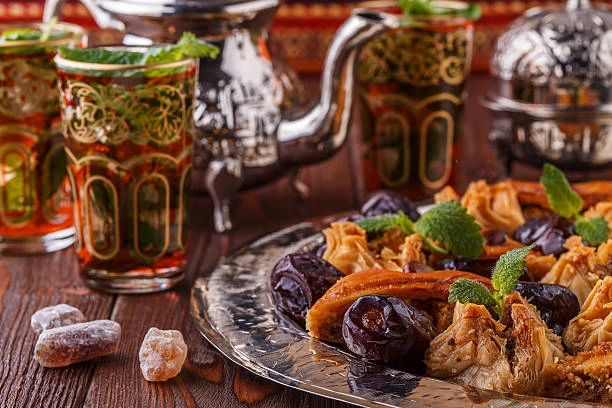
Gathering Your Ingredients
To start making M’hanncha, you’ll need to gather a variety of ingredients, including phyllo pastry, almonds, sugar, and spices. Ensure you have high-quality ingredients to achieve the best flavor and texture. You’ll also need honey and orange blossom water for the syrup, which adds a fragrant and sweet finish to the dessert.
Preparing the Almond Filling
The almond filling is a crucial component of M’hanncha, providing a rich and nutty flavor. To prepare it, you’ll need to grind almonds into a fine texture and mix them with sugar and spices. Be careful not to over-grind the almonds, as this can result in a paste that’s too fine. The filling should be fragrant and slightly coarse.
Assembling and Baking Your Snake Cake
Assembling M’hanncha involves layering phyllo pastry with the almond filling and then shaping it into a spiral design. This process requires patience and a bit of skill, but the result is well worth the effort.
Working with Phyllo Pastry
Phyllo pastry can be delicate to work with, but keeping it moist by covering it with a damp cloth can make the process easier. Layer the phyllo sheets, brushing each with melted butter to create a flaky and golden crust.
Creating the Spiral Shape
To achieve the signature spiral shape of M’hanncha, start by placing the filled phyllo log on a baking sheet and then coiling it into a snake-like shape. This requires a gentle touch to avoid breaking the pastry or displacing the filling.
Baking to Golden Perfection
Bake the M’hanncha in a preheated oven until it’s golden brown. Keep an eye on it to prevent over-browning, as the phyllo can quickly go from perfectly golden to burnt.
Adding the Final Touches
Once baked, drizzle the M’hanncha with a honey syrup infused with orange blossom water. This adds a sweet and fragrant finish to the dessert, enhancing its overall flavor and appeal.
Serving Suggestions
M’hanncha is best served at room temperature, allowing the flavors to meld together beautifully. You can garnish it with powdered sugar or sliced almonds for an extra touch of elegance. This dessert is perfect for special occasions or as a unique treat for your guests.
Delicious Moroccan Fruit Desserts
Moroccan fruit desserts are a perfect blend of traditional flavors and modern twists. You can experience the rich culinary heritage of Morocco through its vibrant fruit desserts.
Moroccan Orange Salad with Cinnamon
The Moroccan Orange Salad is a refreshing dessert made with oranges, cinnamon, and other spices. It’s a simple yet elegant dessert perfect for any occasion.
Selecting and Preparing the Oranges
To make this dessert, you need to select fresh and juicy oranges. Blood oranges are a popular choice due to their deep red color and sweet flavor. Peel the oranges carefully and slice them into thin rounds.
Adding the Perfect Spice Blend
Cinnamon is the key spice in this dessert, adding warmth and depth to the oranges. You can also add a hint of orange blossom water for extra fragrance.
Presentation Tips
Arrange the orange slices on a platter in a decorative pattern. Sprinkle cinnamon powder over the top and garnish with fresh mint leaves for a beautiful presentation.
Spiced Poached Pears
Spiced poached pears are another delightful Moroccan dessert. Pears are poached in a spiced syrup flavored with cinnamon, cloves, and ginger, making them tender and aromatic.
| Dessert | Main Ingredients | Flavor Profile |
|---|---|---|
| Moroccan Orange Salad | Oranges, Cinnamon | Refreshing, Spicy |
| Spiced Poached Pears | Pears, Cinnamon, Cloves, Ginger | Tender, Aromatic |
| Fig and Honey Dessert | Sweet, Nutty |
Fig and Honey Dessert
Figs and honey are a classic combination in Moroccan desserts. Fresh or dried figs are served with a drizzle of honey and sprinkled with toasted almonds, making for a sweet and satisfying treat.
Moroccan Desserts for Special Occasions
Special occasions in Morocco are often marked with traditional desserts that are both delicious and symbolic. You can experience the rich flavors and cultural significance of these sweets during various celebrations throughout the year.
Eid Celebrations: Kaab el Ghazal (Gazelle Horns)
During Eid celebrations, one of the most iconic Moroccan desserts is Kaab el Ghazal, also known as Gazelle Horns. These crescent-shaped pastries are filled with almond paste and topped with powdered sugar. They are not only a delight to eat but also symbolize good fortune and happiness.
Wedding Feasts: Briouat with Almond Paste
At Moroccan wedding feasts, Briouat with almond paste is a common dessert. These small, triangular pastries are filled with a rich almond mixture and fried to perfection. They are then drizzled with honey, making them a sweet and satisfying treat for the wedding guests.
Ramadan Treats: Sfenj (Moroccan Doughnuts)
During Ramadan, Sfenj, or Moroccan doughnuts, are a popular treat. These deep-fried doughnuts are often sprinkled with sugar and enjoyed with a cup of coffee or tea. They are a staple during the holy month, providing a sweet respite after a day of fasting.
| Occasion | Dessert | Description |
|---|---|---|
| Eid | Kaab el Ghazal (Gazelle Horns) | Crescent-shaped pastries filled with almond paste |
| Weddings | Briouat with Almond Paste | Triangular pastries filled with almond mixture and fried |
| Ramadan | Sfenj (Moroccan Doughnuts) | Deep-fried doughnuts sprinkled with sugar |
You can try making these traditional Moroccan desserts at home, using authentic recipes and ingredients to bring a taste of Morocco to your special occasions.
Modern Twists on Traditional Moroccan Desserts
You can give traditional Moroccan desserts a fresh spin by incorporating modern ingredients and techniques. This approach not only honors the rich culinary heritage of Morocco but also makes these desserts appealing to contemporary tastes.
Fusion Recipes to Try at Home
Fusion recipes offer an exciting way to experience Moroccan desserts with a modern twist. For instance, you can make a Moroccan dessert like baklava with a modern ingredient such as matcha or pistachio for a unique flavor profile. Another idea is to incorporate international flavors into traditional Moroccan sweets, like adding a hint of Japanese yuzu to your chebakia.
Healthier Alternatives to Classic Recipes
For those looking for healthier options, traditional Moroccan desserts can be adapted using less sugar, healthier fats, and more nutritious ingredients. For example, you can make a healthier version of sellou by using natural sweeteners like honey instead of refined sugar and adding nuts for extra nutrition.
| Traditional Dessert | Healthier Alternative | Fusion Twist |
|---|---|---|
| Sellou | Using honey instead of sugar | Adding matcha powder for a green tea flavor |
| Chebakia | Baked instead of fried | Incorporating lemon zest for a citrusy flavor |
| Baklava | Using less sugar in the syrup | Adding rose petal jam for an extra layer of flavor |
By experimenting with modern twists on traditional Moroccan desserts, you can enjoy the rich flavors of Morocco in new and exciting ways. Whether you’re making fusion recipes or healthier alternatives, the key is to have fun and be creative in the kitchen.
Conclusion: Bringing Morocco’s Sweet Flavors to Your Kitchen
Now that you’ve explored the rich world of Moroccan desserts, it’s time to bring these sweet flavors to your kitchen. With the recipes and tips provided, you can recreate the magic of Moroccan cuisine at home.
From the honey-soaked Chebakia to the delicate layers of Baklava, Moroccan desserts offer a unique blend of flavors and textures. You can experiment with different ingredients, such as orange blossom water and rose water, to create authentic Moroccan desserts.
As you try making these delicious treats, you’ll discover the joy of sharing Moroccan food desserts with family and friends. Whether you’re celebrating a special occasion or simply satisfying your sweet tooth, Moroccan desserts are sure to impress.
So, get started on your culinary journey and indulge in the sweet world of Moroccan cuisine. Explore the various recipes, experiment with new flavors, and enjoy the delightful experience of creating and savoring Moroccan desserts.

